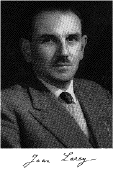Fields Mathematics | Role Mathematician Name Jean Leray | |
 | ||
Institutions University of NancyUniversity of ParisCollege de France Alma mater Ecole Normale Superieure Doctoral students Armand BorelIstvan FaryJean VaillantClaude Wagschal Notable awards Malaxa Prize (1938)Feltrinelli Prize (1971)Wolf Prize in Mathematics (1979)Lomonosov Gold Medal (1988) Books Lagrangian Analysis and Quantum Mechanics: A Mathematical Structure Related to Asymptotic Expansions and the Maslov Index Similar People Paul Malliavin, Tosio Kato, Armand Borel, Gunter Ewald, Angus Ellis Taylor | ||
Education Ecole Normale Superieure | ||
Comedians in cars feat jean leray
Jean Leray ([ləʁɛ]; 7 November 1906 – 10 November 1998) was a French mathematician, who worked on both partial differential equations and algebraic topology.
Contents
- Comedians in cars feat jean leray
- 17 spectral sequence 0 motivation and introduction
- Life and career
- References
1.7 spectral sequence 0 motivation and introduction
Life and career
He was born in Chantenay-sur-Loire (today part of Nantes). He studied at École Normale Supérieure from 1926 to 1929. He received his Ph.D. in 1933. Leray wrote an important paper that founded the study of weak solutions of the Navier–Stokes equations. Together with Juliusz Schauder, he discovered a topological invariant, now called the Leray–Schauder degree, which they applied to prove the existence of solutions for partial differential equations lacking uniqueness.
From 1938 to 1939 he was professor at the University of Nancy. He did not join the Bourbaki group, although he was close with its founders.
His main work in topology was carried out while he was in a prisoner of war camp in Edelbach, Austria from 1940 to 1945. He concealed his expertise on differential equations, fearing that its connections with applied mathematics could lead him to be asked to do war work.
Leray's work of this period proved seminal to the development of spectral sequences and sheaves. These were subsequently developed by many others, each separately becoming an important tool in homological algebra.
He returned to work on partial differential equations from about 1950.
He was professor at the University of Paris from 1945 to 1947, and then at the Collège de France until 1978.
He was awarded the Malaxa Prize (Romania, 1938), the Grand Prix in mathematical sciences (French Academy of Sciences, 1940), the Feltrinelli Prize (Accademia dei Lincei, 1971), the Wolf Prize in Mathematics (Israel, 1979), and the Lomonosov Gold Medal (Moscow, 1988).
